stop start CHEVROLET ASTRO 1998 2.G Owners Manual
[x] Cancel search | Manufacturer: CHEVROLET, Model Year: 1998, Model line: ASTRO, Model: CHEVROLET ASTRO 1998 2.GPages: 414, PDF Size: 21.46 MB
Page 61 of 414
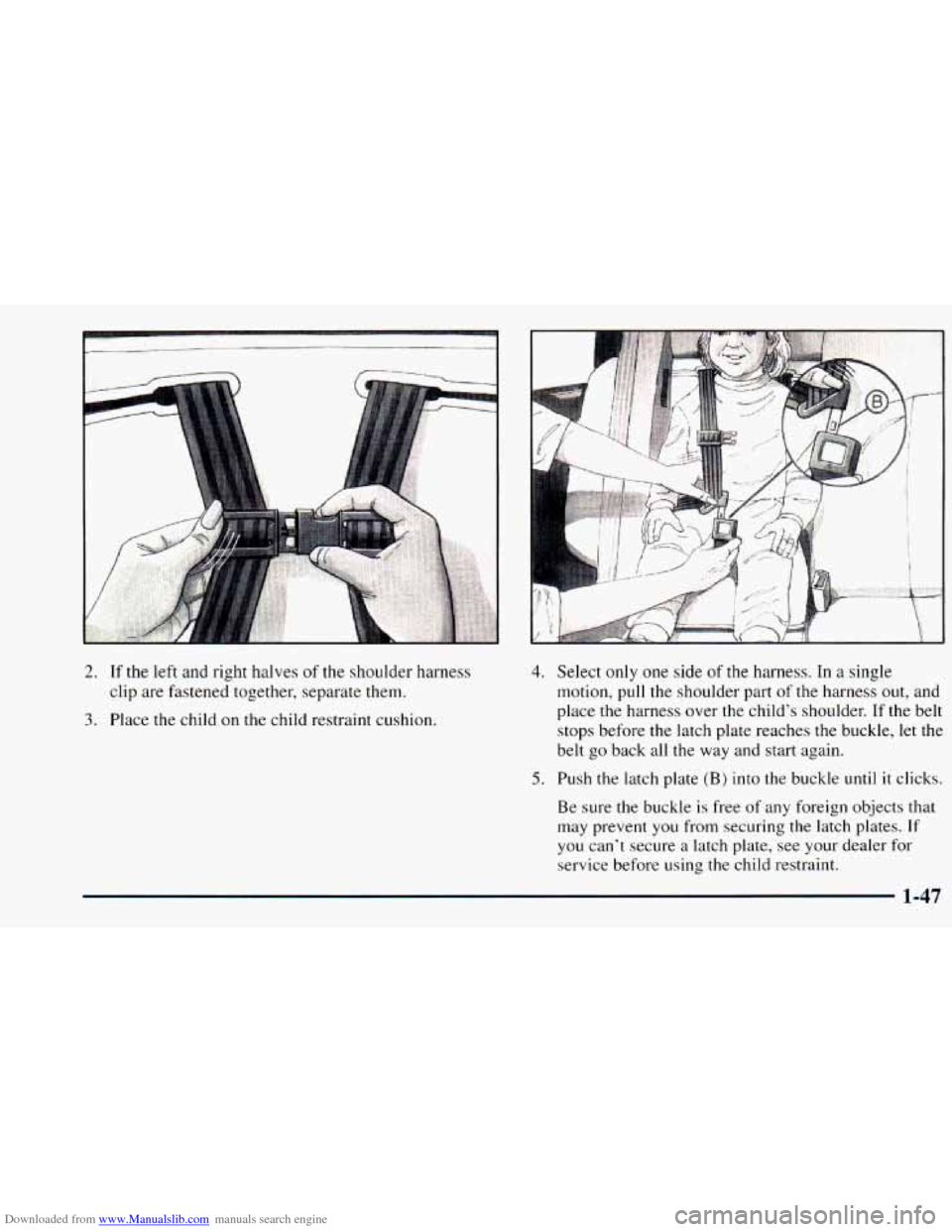
Downloaded from www.Manualslib.com manuals search engine 2. If the left and right halves of the shoulder harness
clip are fastened together, separate them.
3. Place the child on the child restraint cushion.
4. Select only one side of the harness. In a single
motion, pull the shoulder part
of the harness out, and
place
the harness over the child's shoulder. If the belt
stops before
the latch plate reaches the buckle, let the
belt go back all the way and start again.
5. Push the latch plate (B) into the buckle until it clicks.
Be sure the buckle
is free of any foreign objects that
may prevent you from securing the latch plates.
If
you can't secure a latch plate, see your dealer for
service before using the child restraint.
1-47
Page 62 of 414
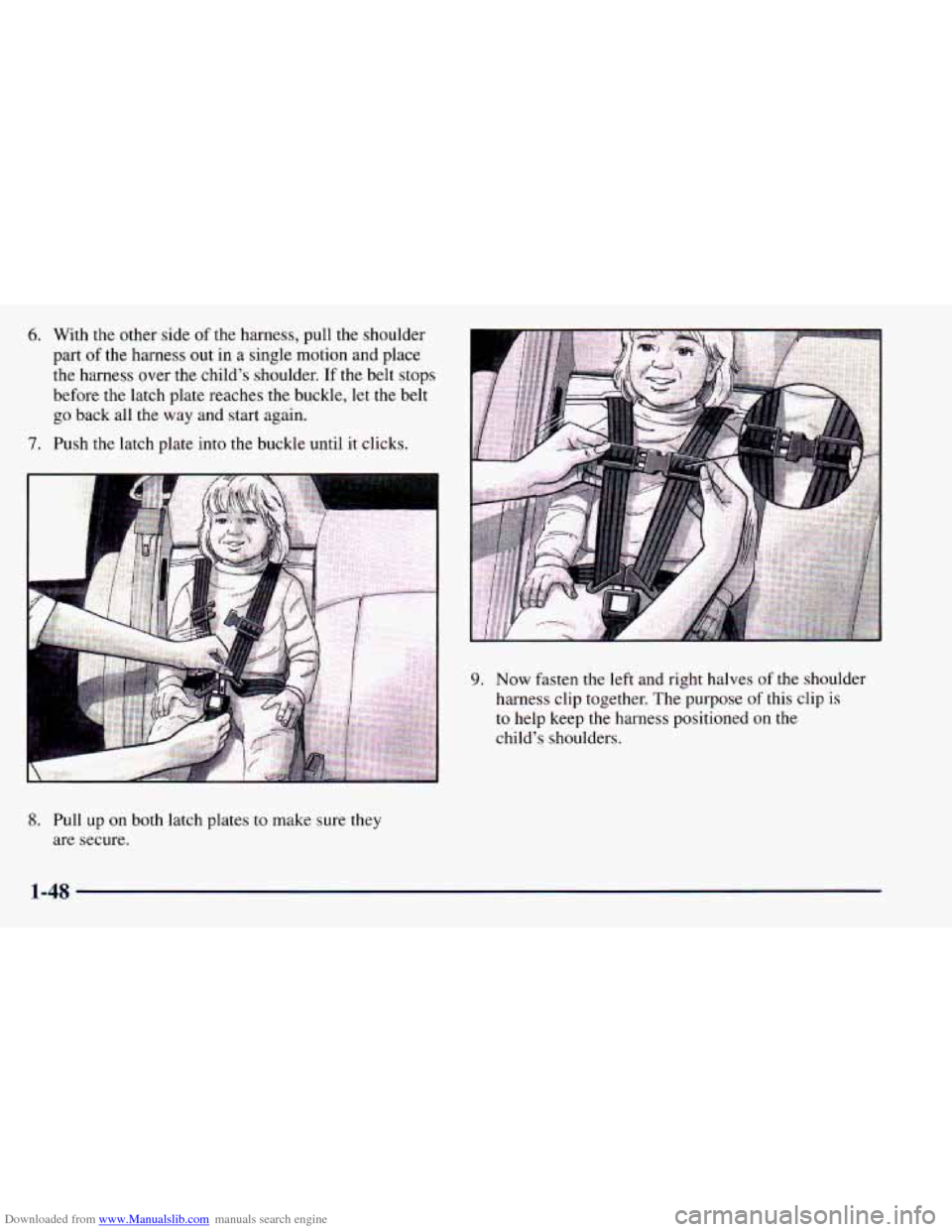
Downloaded from www.Manualslib.com manuals search engine 6. With the other side of the harness, pull the shoulder
part
of the harness out in a single motion and place
the harness over the child's shoulder.
If the belt stops
before the latch plate reaches the buckle, let the belt
go back all the way and start again.
7. Push the latch plate into the buckle until it clicks.
8. Pull up on both latch plates to make sure they
are secure.
9. Now fasten the left and right halves of the shoulder
harness clip together. The purpose
of this clip is
to help keep the harness positioned on the
child's shoulders.
1-48
Page 99 of 414
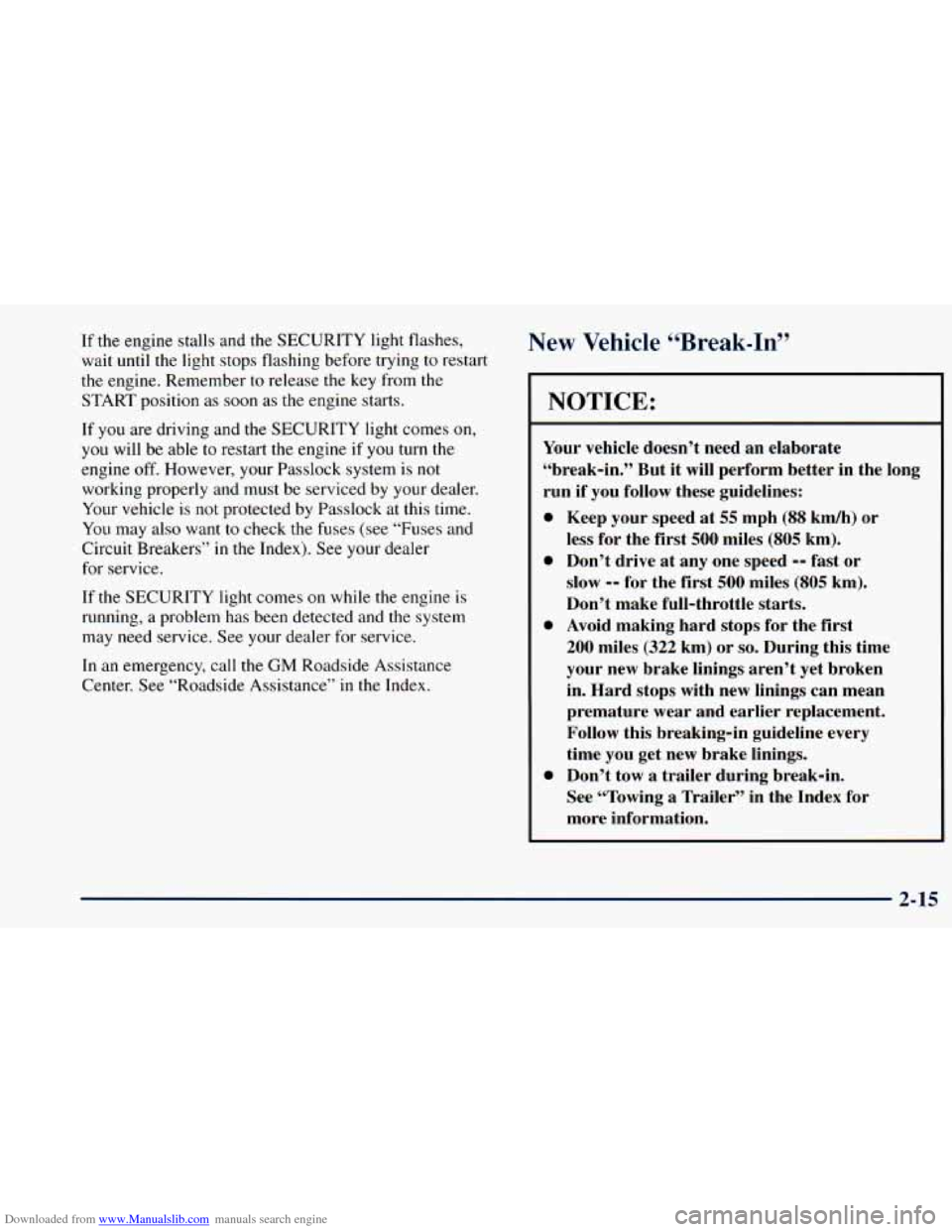
Downloaded from www.Manualslib.com manuals search engine If the engine stalls and the SECURITY light flashes,
wait until the light stops flashing before trying to restart
the engine. Remember to release the key from the
START position as soon as the engine starts.
If you are driving and the SECURITY light comes on,
you will be able to restart the engine if you turn the
engine
off. However, your Passlock system is not
working properly and must be serviced by your dealer.
Your vehicle is not protected by Passlock at this time.
You may also want
to check the fuses (see “Fuses and
Circuit Breakers”
in the Index). See your dealer
for service.
If the SECURITY light comes on while the engine is
running, a problem has been detected and the system
may need service. See your dealer for service.
In an emergency, call
the GM Roadside Assistance
Center.
See “Roadside Assistance” in the Index.
New Vehicle “Break-In”
NOTICE:
Your vehicle doesn’t need an elaborate
“break-in.” But it will perform better in the long
run if you follow these guidelines:
0
0
0
0
Keep your speed at 55 mph (88 kmh) or
less for the first
500 miles (805 km).
Don’t drive at any one speed
-- fast or
slow
-- for the first 500 miles (805 km).
Don’t make full-throttle starts.
Avoid making hard stops for the first
200 miles (322 km) or so. During this time
your new brake linings aren’t yet broken
in. Hard stops with new linings can mean
premature wear and earlier replacement.
Follow this breaking-in guideline every
time you get new brake linings.
Don’t tow
a trailer during break-in.
See “Towing
a Trailer” in the Index for
more information.
2-15
Page 101 of 414
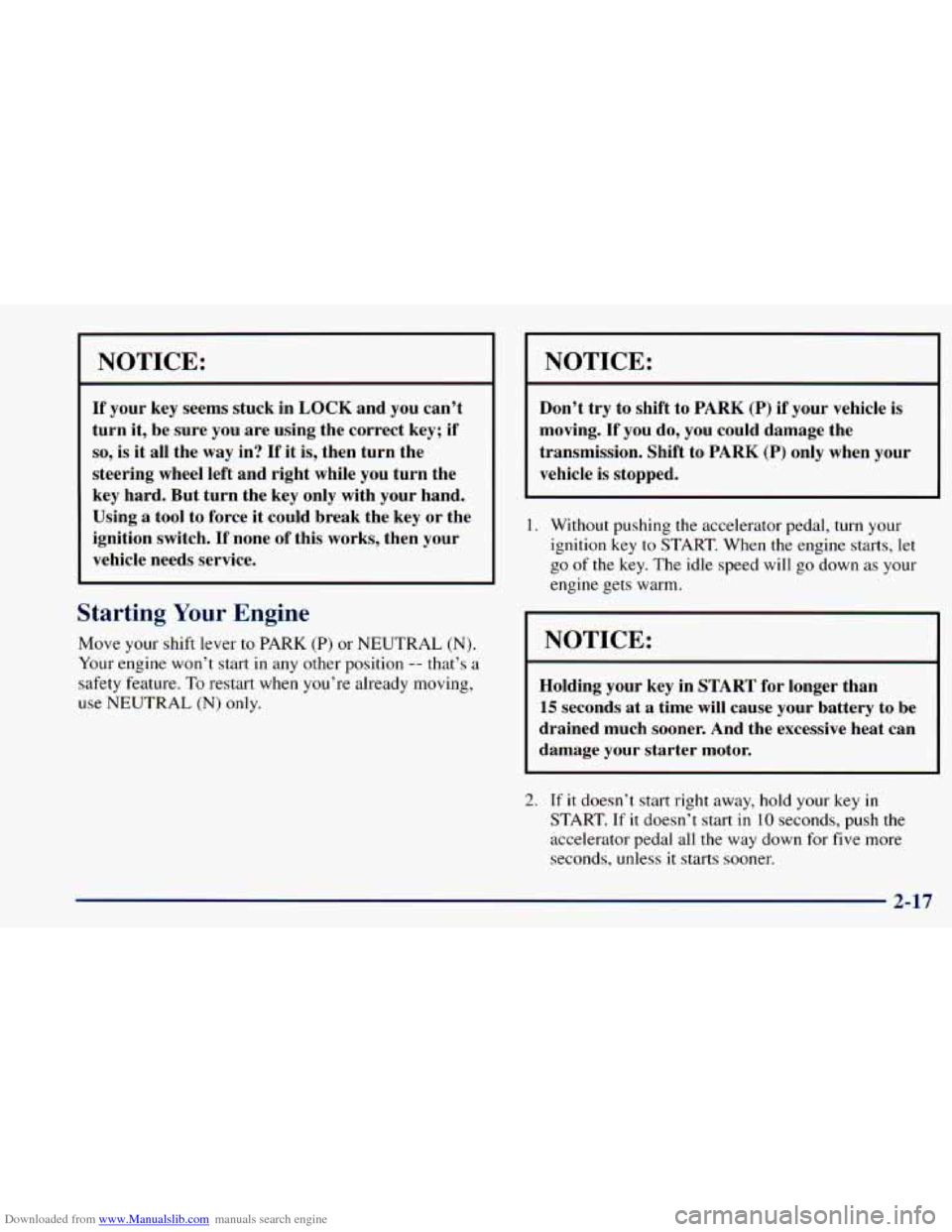
Downloaded from www.Manualslib.com manuals search engine NOTICE:
If your key seems stuck in LOCK and you can’t
turn it, be sure you are using the correct key;
if
so, is it all the way in? If it is, then turn the
steering wheel left and right while you turn the
key hard. But turn the key only with your hand.
Using
a tool to force it could break the key or the
ignition switch.
If none of this works, then your
vehicle needs service.
Starting Your Engine
Move your shift lever to PARK (P) or NEUTRAL (N).
Your engine won’t start in any other position -- that’s a
safety feature.
To restart when you’re already moving,
use NEUTRAL (N) only.
NOTICE:
Don’t try to shift to PARK (P) if your vehicle is
moving.
If you do, you could damage the
transmission. Shift to PARK
(P) only when your
vehicle is stopped.
1. Without pushing the accelerator pedal, turn your
ignition key
to START. When the engine starts, let
go of the key. The idle speed will go
down as your
engine gets warm.
NOTICE:
Holding your key in START for longer than
15 seconds at a time will cause your battery to be
drained much sooner. And the excessive heat can
damage your starter motor.
2. If it doesn’t start right away, hold your key in
START. If it doesn’t start in 10 seconds, push the
accelerator pedal all the way down for five more
seconds, unless
it starts sooner.
2-17
Page 102 of 414
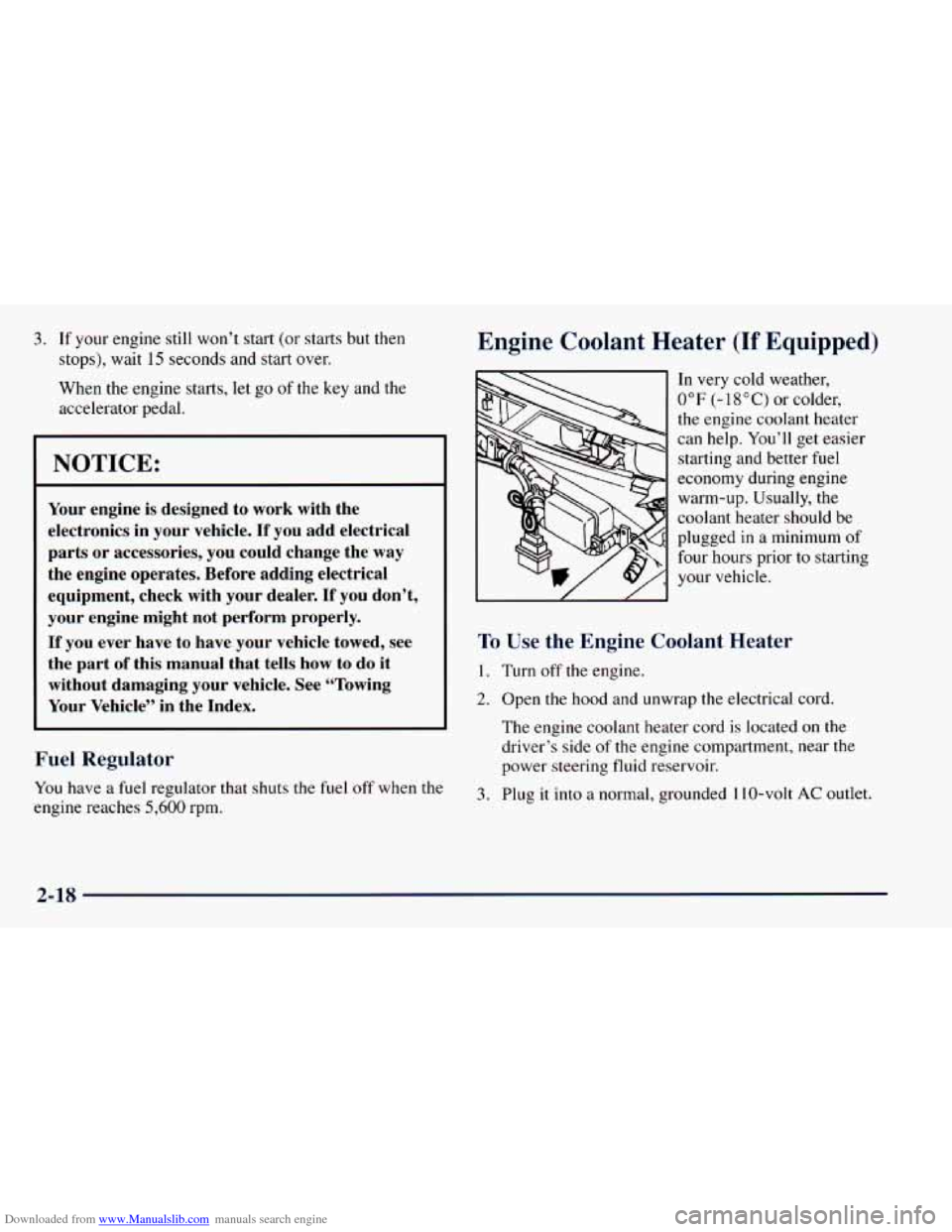
Downloaded from www.Manualslib.com manuals search engine 3. If your engine still won’t start (or starts but then
stops), wait
15 seconds and start over.
When the engine starts, let go
of the key and the
accelerator pedal.
I NOTICE:
Your engine is designed to work with the
electronics in your vehicle. If you add electrical
parts or accessories, you could change the way
the engine operates. Before adding electrical
equipment, check with your dealer. If you don’t,
your engine might not perform properly.
If you ever have to have your vehicle towed, see
the part
of this manual that tells how to do it
without damaging your vehicle. See “Towing
Your Vehicle” in the Index.
Fuel Regulator
You have a fuel regulator that shuts the fuel off when the
engine reaches
5,600 rpm.
Engine Coolant Heater (If Equipped)
In very cold weather,
0°F (-18°C) or colder,
the engine coolant heater
can help. You’ll get easier
starting and better
fuel
economy during engine
warm-up. Usually, the
coolant heater should
be
plugged in a minimum of
four hours prior to starting
your vehicle.
To Use the Engine Coolant Heater
1. Turn off the engine.
2. Open the hood and unwrap the electrical cord.
The engine coolant heater cord is located on the
driver’s side
of the engine compartment, near the
power steering fluid reservoir.
3. Plug it into a normal, grounded 110-volt AC outlet.
2-18
Page 104 of 414
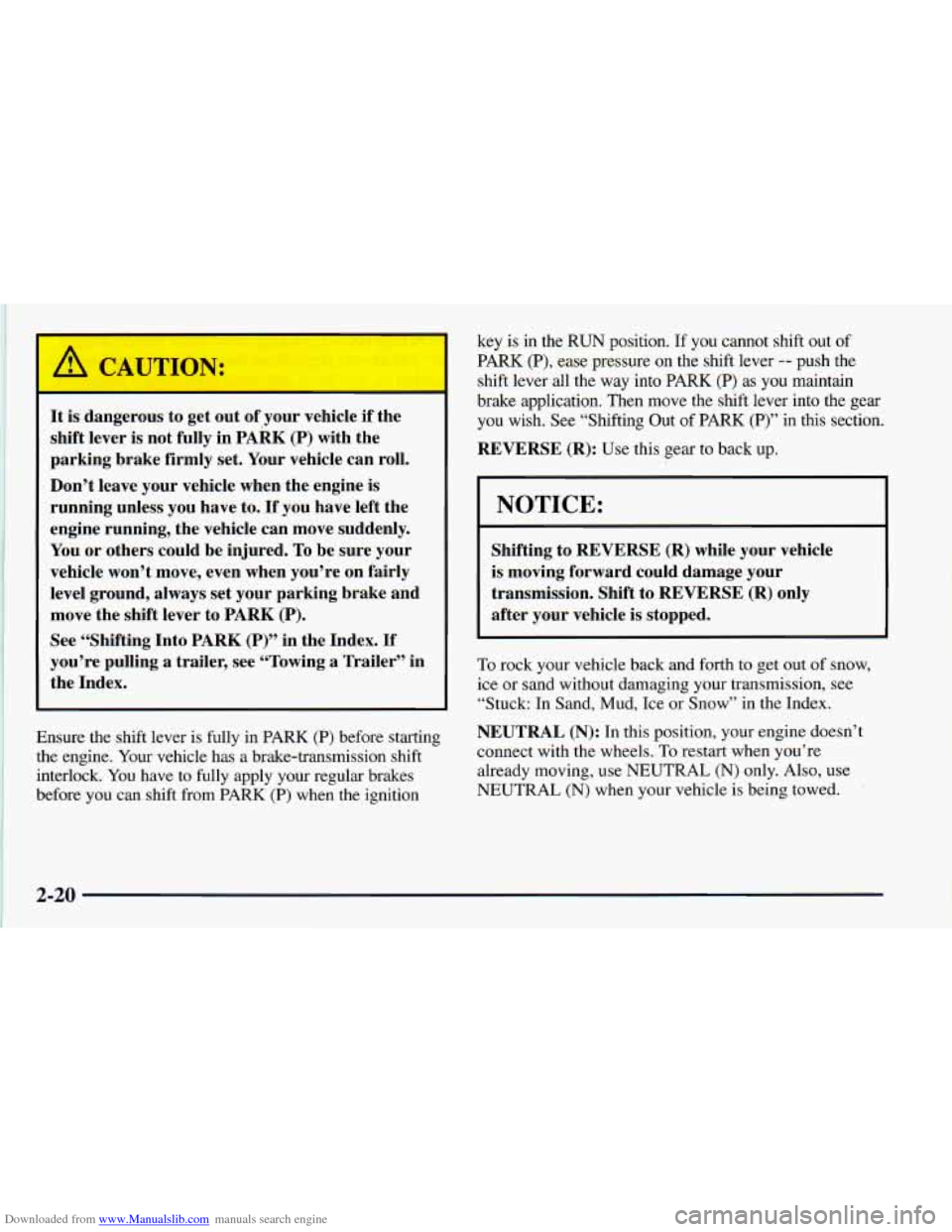
Downloaded from www.Manualslib.com manuals search engine A CAUhON:
It is dangerous to get out of your vehicle if the
shift lever
is not fully in PARK (P) with the
parking brake firmly set. Your vehicle can roll.
Don’t leave your vehicle when the engine is
running unless you have to.
If you have left the
engine running, the vehicle can move suddenly.
You or others could be injured. To be sure your
vehicle won’t move, even when you’re on fairly
level ground, always set your parking brake and
move the shift lever to
PARK (P).
See “Shifting Into PARK (P)” in the Index. If
you’re pulling a trailer, see “Towing a Trailer” in
the Index.
Ensure the shift lever
is fully in PARK (P) before starting
the engine. Your vehicle has a brake-transmission shift
interlock. You have to fully apply your regular brakes
before you can shift from
PARK (P) when the ignition key is in the
RUN position. If you cannot shift out of
PARK (P), ease pressure on the shift lever
-- push the
shift lever all the way into
PARK (P) as you maintain
brake application. Then move the shift lever into the gear you wish. See “Shifting Out of PARK
(P)” in this section.
REVERSE (R): Use this gear to back up.
NOTICE:
Shifting to REVERSE (R) while your vehicle
is moving forward could damage your
transmission. Shift to
REVERSE (R) only
after your vehicle is stopped.
To rock your vehicle back and forth to get out of snow,
ice or sand without damaging your transmission, see
“Stuck: In Sand, Mud,
Ice or Snow” in the Index.
NEUTRAL (N): In this position, your engine doesn’t
connect with the wheels.
To restart when you’re
already moving, use NEUTRAL
(N) only. Also, use
NEUTRAL
(N) when your vehicle is being towed. ’
2-20
Page 105 of 414
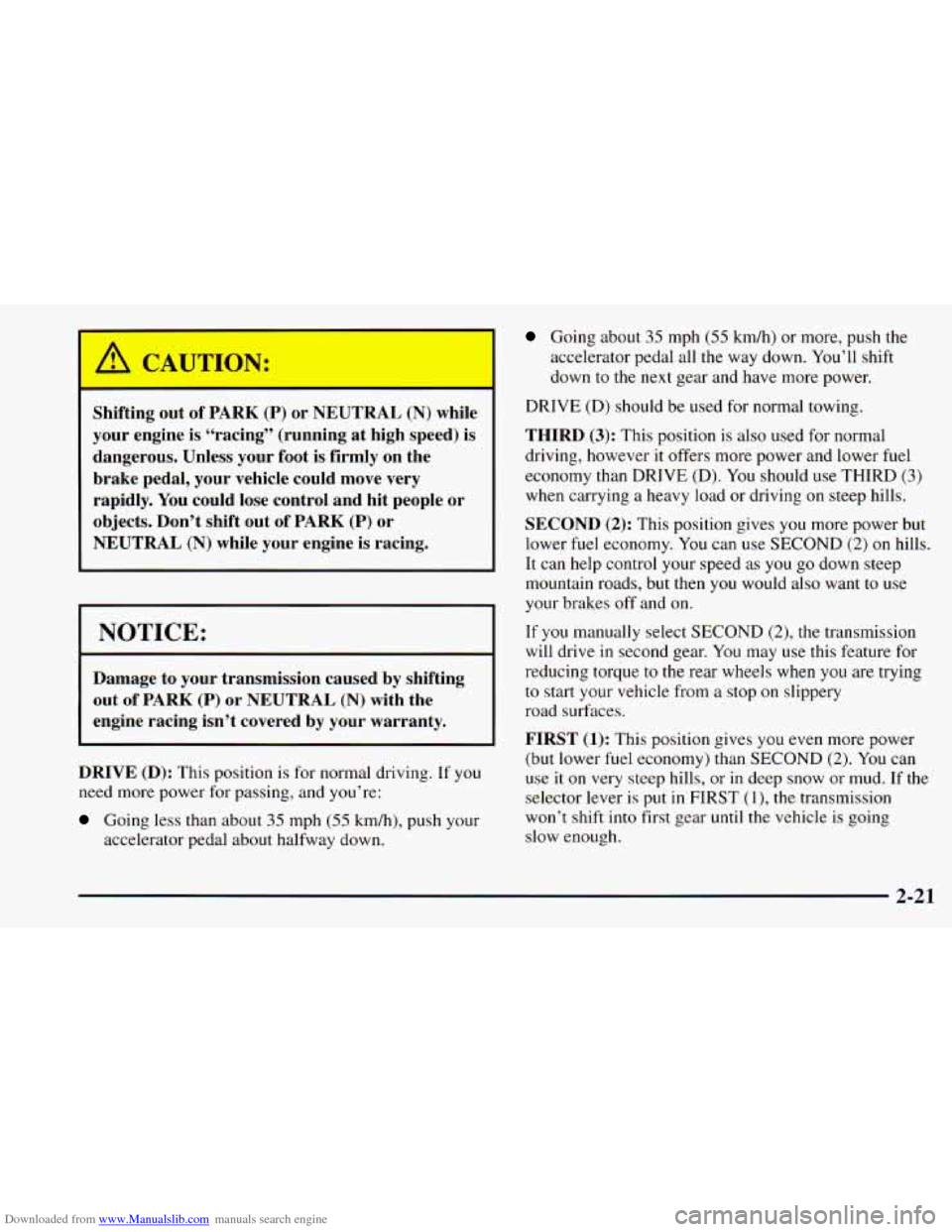
Downloaded from www.Manualslib.com manuals search engine -
A CAUTION:
--
Shifting out of PARK (P) or NEUTRAL (N) while
your engine is “racing” (running at high speed) is
dangerous. Unless your foot is firmly on the
brake pedal, your vehicle could move very
rapidly. You could lose control and hit people or
objects. Don’t shift out
of PARK (P) or
NEUTRAL
(N) while your engine is racing.
NOTICE:
Damage to your transmission caused by shifting
out
of PARK (P) or NEUTRAL (N) with the
engine racing isn’t covered by your warranty.
DRIVE (D): This position is for normal driving. If you
need more power for passing, and you’re:
Going less than about 35 mph (55 km/h), push your
accelerator pedal about halfway down.
Going about 35 mph (55 km/h) or more, push the
accelerator pedal all the way down. You’ll shift
down to the next gear and have more power.
DRIVE (D) should be used for normal towing.
THIRD
(3): This position is also used for normal
driving, however it offers more power and lower fuel
economy than DRIVE (D). You should use THIRD
(3)
when carrying a heavy load or driving on steep hills.
SECOND
(2): This position gives you more power but
lower
fuel economy. You can use SECOND (2) on hills.
It can help control your speed as
you go down steep
mountain roads, but then
you would also want to use
your brakes off and
on.
If you manually select SECOND (2), the transmission
will drive
in second gear. You may use this feature for
reducing torque to the
rear wheels when you are trying
to start your vehicle from a stop on slippery
road surfaces.
FIRST
(1): This position gives you even more power
(but lower fuel economy) than SECOND
(2). You can
use it on very steep hills, or in deep snow or mud. If the
selector lever is put in FIRST
(l), the transmission
won’t shift into first gear until the vehicle is going
slow enough.
2-21
Page 116 of 414
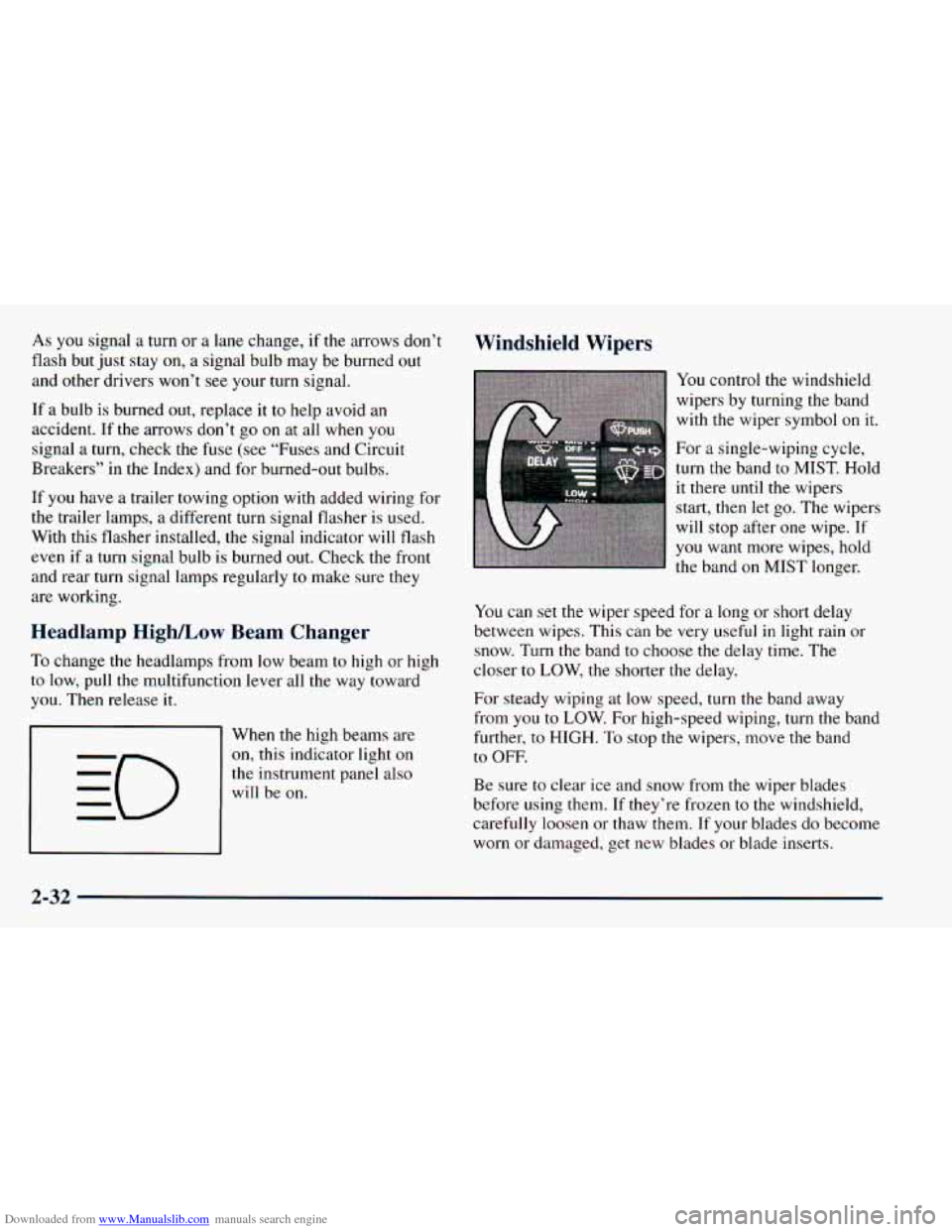
Downloaded from www.Manualslib.com manuals search engine As you signal a turn or a lane change, if the arrows don’t
flash but just stay on, a signal bulb may be burned out
and other drivers won’t see your turn signal.
If a bulb is burned
out, replace it to help avoid an
accident. If the arrows don’t go
on at all when you
signal a turn, check the fuse (see “Fuses and Circuit
Breakers” in the Index) and for burned-out bulbs.
Windshield Wipers
You control the windshield
wipers by turning
the band
with the wiper symbol on it.
- .- .. For a single-wiping cycle,
a turn the band to MIST. Hold m
If you have a trailer towing option with added wiring for
the trailer lamps, a different turn signal flasher is used.
With this flasher installed, the signal indicator
will flash
even if
a turn signal bulb is burned out. Check the front
and rear turn signal lamps regularly
to make sure they it there
until the wipers
start, then let go. The wipers
will stop after
one wipe. If
you want more wipes, hold
the band on MIST longer.
are working.
Headlamp HighLow Beam Changer between wipes. This can be very useful in light rain or
To change the headlamps from low beam to high or high closer to Low, the shorter the delay,
to low,
pull the multifunction lever all the way toward You
can set the wiper speed for a long or short delay
snow. Turn the band
to choose the delay time. The
you. Then release it.
When the high beams are
on, this indicator light on
the instrument panel also
will be
on.
For steady wiping at low speed, turn the band away
from
you to LOW. For high-speed wiping, turn the band
further, to HIGH.
To stop the wipers, move the band
to OFF.
Be sure to clear ice and snow from the wiper blades
before using them. If they’re frozen
to the windshield,
carefully loosen or thaw them. If your blades do become
worn or damaged, get new blades or blade inserts.
2-32
Page 131 of 414
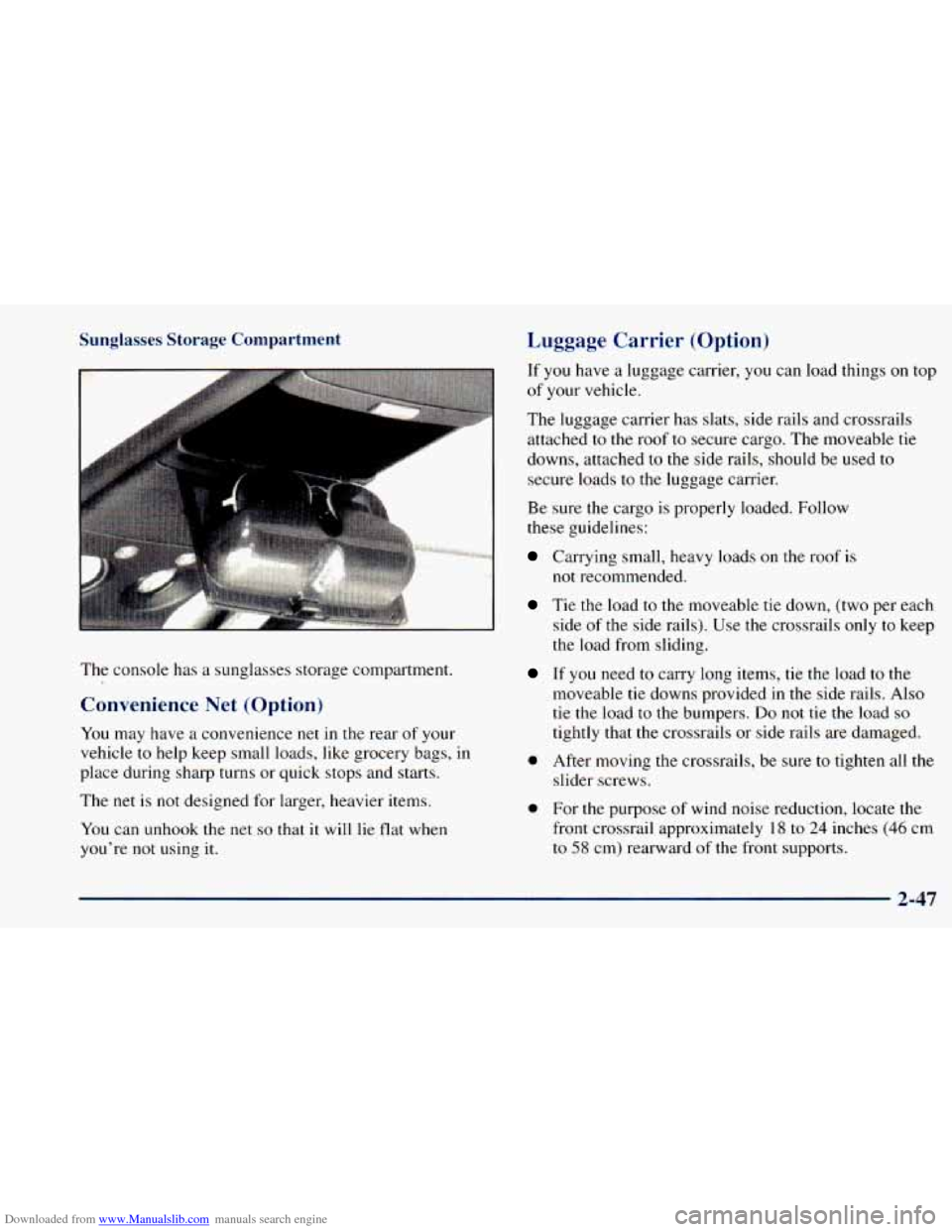
Downloaded from www.Manualslib.com manuals search engine Sunglasses Storage Compartment
The console has a sunglasses storage compartment.
Convenience Net (Option)
You may have a convenience net in the rear of your
vehicle
to help keep small loads, like grocery bags, in
place during sharp turns or quick stops and starts.
The
net is not designed for larger, heavier items.
You can unhook the net
so that it will lie flat when
you're
not using it.
Luggage Carrier (Option)
If you have a luggage carrier, you can load things on top
of your vehicle.
The luggage carrier has slats, side rails and crossrails
attached to the roof to secure cargo. The moveable tie
downs, attached
to the side rails, should be used to
secure loads to the luggage carrier.
Be sure the cargo
is properly loaded. Follow
these guidelines:
Carrying small, heavy loads on the roof is
Tie the load to the moveable tie down, (two per each
side
of the side rails). Use the crossrails only to keep
the load from sliding.
not recommended.
If you need to carry long items, tie the load to the
moveable tie downs provided in the side rails. Also
tie the load to the bumpers. Do not tie the load so
tightly that the crossrails or side rails are damaged.
0 After moving the crossrails, be sure to tighten all the
slider screws.
0 For the purpose of wind noise reduction, locate the
front crossrail approximately
18 to 24 inches (46 cm
to 58 cm) rearward of the front supports.
2-47
Page 145 of 414
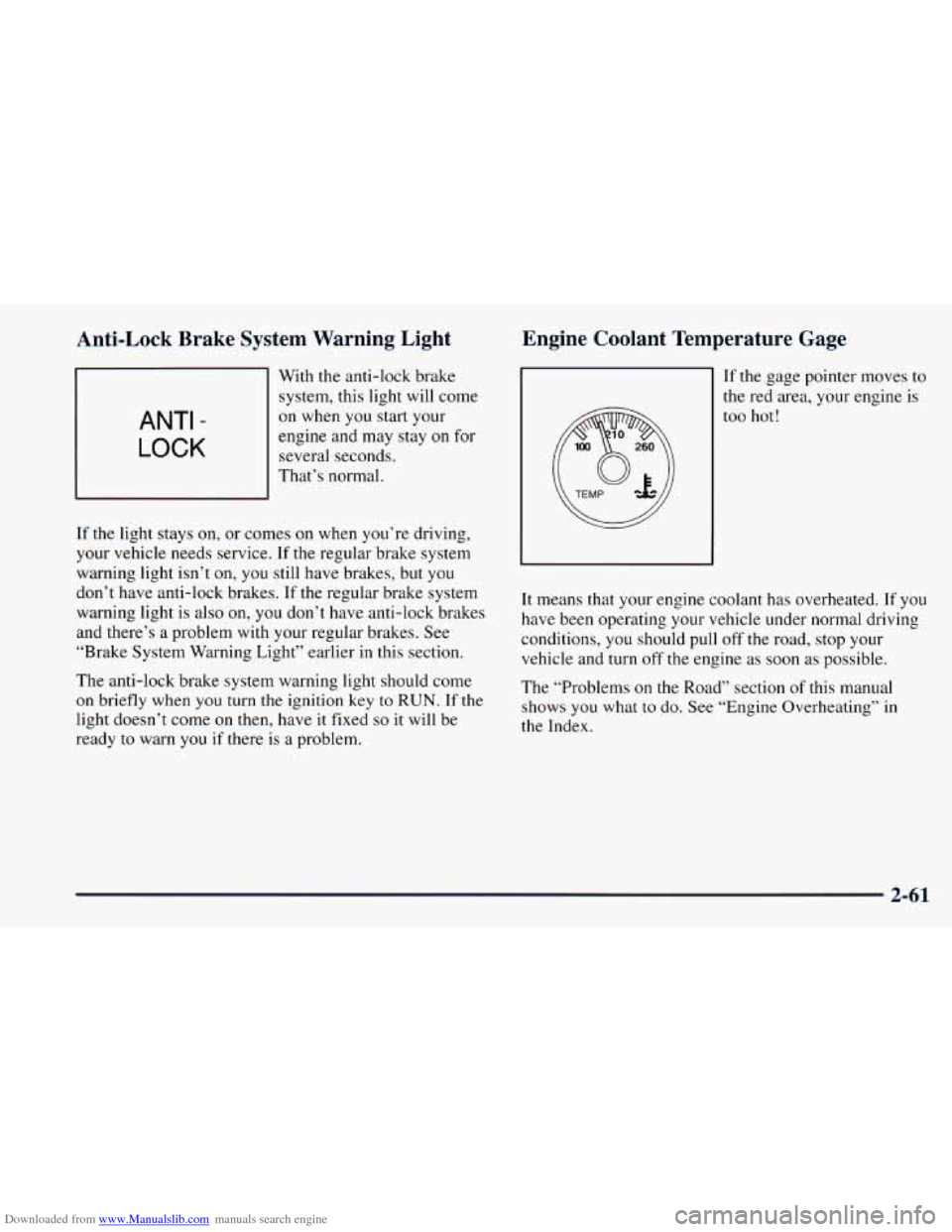
Downloaded from www.Manualslib.com manuals search engine Anti-Lock Brake System Warning Light
ANTI -
LOCK
With the anti-lock brake
system, this light will come
on when
you start your
engine and may stay
on for
several seconds.
That’s normal.
If the light stays on, or comes on when you’re driving,
your vehicle needs service.
If the regular brake system
warning light isn’t on,
you still have brakes, but you
don’t have anti-lock brakes.
If the regular brake system
warning light is also on, you don’t have anti-lock brakes
and there’s a problem with your regular brakes. See
“Brake System Warning Light’’ earlier in this section.
The anti-lock brake system warning light should come
on briefly when you turn the ignition key to RUN. If the
light doesn’t come on then, have
it fixed so it will be
ready to warn
you if there is a problem.
Engine Coolant Temperature Gage
If the gage pointer moves to
the red area, your engine
is
too hot!
It means that your engine coolant has overheated. If you
have been operating your vehicle under normal driving
conditions,
you should pull off the road, stop your
vehicle and turn off the engine as soon as possible.
The “Problems on the Road” section of this manual
shows
you what to do. See “Engine Overheating” in
the Index.
2-61